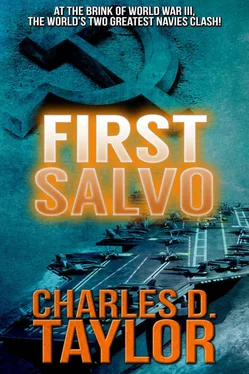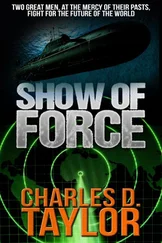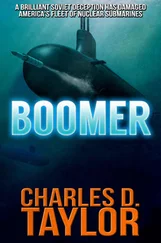As Carleton had explained earlier to Dave Pratt, Yorktown was everything they had designed her for — and more. Without AEGIS, there would have been no doubt about the outcome of the Battle of the Mediterranean. The Soviets’ first salvo was intended to eliminate resistance, and the ferocity of the effort could only be understood by those who had studied Soviet strategy. With the exception of the use of atomic weapons to end the war in Japan, never before had so much explosive been used at one time by mankind.
As the Backfires crossed the southeastern Greek islands, Tom Carleton ordered AEGIS into automatic. Then electronic warfare devised by man took over man’s battle. The computer was able to search and catalogue hundreds of contacts at one time; it was fed information on aircraft and air-to-surface missiles by the giant fixed-array radar. Secondary radars catalogued all surface contacts, and sonar delivered data on the undersea picture. The computer also received information from Hawkeye aircraft hundreds of miles out on the perimeter, from individual ships in outer stations, and would have accepted everything sent to it by recon satellites.
Once an object was recorded by the computer, it was then identified as either friend or foe and appeared on the appropriate display console or status board. The next step was threat evaluation — to determine which of the hundreds of catalogued targets offered the most immediate threat to the battle group. AEGIS would then select the appropriate weapon, whether on board Yorktown or on another ship attached by LINK to the battle group. Once the weapon was fired, AEGIS remained in touch with the situation until the threat no longer existed.
AEGIS instantly processed every bit of information within electronic range, notwithstanding the electronic countermeasures presented to it. The Soviets utilized jammers of their own, responding to search radar by returning dual or triple images where only one existed. As the Soviets came within range of the battle group, they launched their own anti-radiation missiles which homed in on search and fire-control radars.
Electronic warfare has little concern for blast effect — its basis is purely deception, the creation of countermeasures and countercountermeasures. Damage — and unimaginable loss of life — occurs as the result of a simple failure, the failure of a microchip, the failure of a circuit to open or to close according to design.
These thoughts coursed through Tom Carleton’s mind as he watched the scene develop in Yorktown ’s CIC. AEGIS’s computer system faithfully recorded successes and failures faster than the human mind could assimilate them.
The initial hit on Yorktown did not seem overly serious at the time in comparison with what might have been damaged. The starboard Phalanx exploded a missile warhead an instant before it hit the ship. It was aft, just behind the number-two engine room, where damage could have been critical. Yet an explosion that close does inflict damage, and in this case, the explosive force tore into the hull at water level, opening up the generator room and damaging the number-three generator. Damage control isolated the area immediately.
When an electrical failure occurs on an AEGIS cruiser, there is a load-shedding feature that transmits power requirements to the remaining two generators. If one generator fails, the system sheds electrical demand by various sectors of the ship to avoid overload. In this case, Carleton noted with relief, there was only a momentary dimming of the AEGIS system before it continued normal operation. Those parts of the ship requiring electrical power would be quickly brought back on line through crossconnecting by the damage-control parties.
Yorktown continued on her way, steadily closing on the enemy forces, steadily managing the battle with her powerful computer.
The second hit, however, was more critical. This time there was no last-minute save by Phalanx. A cruise missile plunged into the bow, destroying the three upper sonar equipment rooms. Yorktown ’s ability to detect submarines was lost in an instant, but this was not critical to the battle group; other ships could relay the ASW picture. Of greater import was the fire that the blast generated. Within moments, the high-temperature alarms went off in the magazines below the forward five-inch mount. Damage control reported to Carleton that they were unable to control the fires in time to save the magazines. He was forced to order them flooded.
It was at this stage that a quirk of luck, or nature, occurred that threatened to change the outcome of the battle. Though Kennedy ’s battle group was sustaining heavy damage, Kennedy was still moving east toward the enemy surface force. The carrier, though still burning, could still recover aircraft — Yorktown ’s AEGIS still controlled the defense.
A Soviet Alfa-class submarine, one of those that had been worrying Admiral Pratt for more than twenty-four hours, was the cause. They are the fastest and quietest of the Russian submarine armada. Their titanium hulls make sonar detection extremely difficult. They are the deepest diving submarine known and they are highly automated. This particular submarine, Odessa , had escaped contact more than thirty-six hours before. Diving deep, she avoided the infrared capability of the recon satellites. Finding security under a layer of extremely cold water that defied sonar detection, she cruised slowly and very quietly under Kennedy’s battle group.
Odessa ’s captain was a brave man. He had no knowledge of what was taking place above him — only that the enemy was above, that his listening gear was so full of explosions that he could not differentiate targets, and that his operation order stated that a massive attack on the American battle group should now be under way. The only chance he had to make a contribution to the battle was to bring Odessa as close to the surface, and the battle, as possible. He brought his boat to as fast a speed as he could attain at a maximum up angle. His torpedo tubes were loaded, his men ready to fire the instant the submarine had a target. Perhaps the captain was too anxious or his diving officer’s attention was diverted by the action above. Whatever the cause, she broke the surface of the Mediterranean in the midst of the battle group like a whale breaching. American sonars had heard Odessa ’s rush, but the act was so fast, so unexpected, so brash, that before they could react, Odessa had fired six torpedoes — four from her forward tubes, two from the stern tubes. Then, as quickly as she had appeared, she dove. Again her captain attempted the impossible. Achieving a critical down angle, he combined speed and rapid flooding of his tanks to escape. It was dangerous. The extremes he exercised were beyond those in the submarine manual.
Odessa ’s noisy dive was easily tracked by two destroyers to the rear of the carrier protecting K ennedy ’s flank. They fired rocket-propelled torpedoes from their ASROC launchers well ahead of Odessa ’s position. The submarine was faster, but the homing torpedoes had the lead time and she was an easy target. The submarine never came out of her crash dive to prove to her builders how much an Alfa-class submarine could exceed engineering standards. Two torpedoes fractured her pressure hull and Odessa continued on her last dive at full speed. Increasing water pressure ripped her into pieces, compartment by compartment.
On the surface, chaos ensued. Each ship was streaming its NIXIE decoys but Odessa had fired at the two major contacts that had appeared on her attack computer — Kennedy and Yorktown . Two of the torpedoes from Odessa ’s forward tubes swerved slightly off course to attack the carrier’s decoys, but the others raced directly into Kennedy ’s hull. The first struck aft, opening the after engine room to the sea. Fuel storage tanks ruptured, feeding the flames that erupted. Burst fire mains once again cut the water to the damage control parties on the hangar deck above.
Читать дальше












